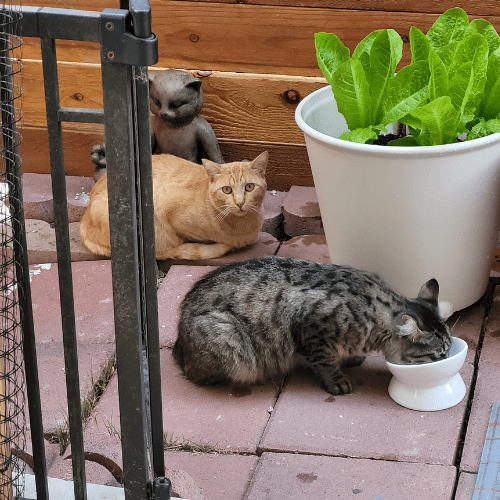
What To Do If You Find A Stray Cat
If you find a stray cat, you should determine if it is feral or tame. Tame cats can be adopted into families and kept inside, which will give them a longer, less stressful life. Feral cats can be trapped, neutered, and returned to their environment to control the local cat population.
In this article, we’ll discuss what to do with stray cats, and how you can take them in, rehome them, or care for them outdoors.
What is a stray cat?
A stray cat is a pet that has been abandoned or lost and is now living on the streets. They are usually scared, hungry, and in need of assistance. The best thing you can do for them is to provide food, water, shelter, and care until you can find them a safe forever home to live in.
If the cat has a collar, then it may be a lost cat, and you should try to find the owner’s contact information. A veterinarian would be able to scan the cat’s microchip if it has one to find the cat’s owner.
Stray cats are typically found in areas where food and shelter are easily accessible, such as an alleyway, behind a store, or near a dumpster. In addition, feral cats often find their way into abandoned buildings and garages. Stray cats also tend to seek refuge near human dwellings.

If the cat has an ear tip or ear clip, it is likely a feral cat. However, that doesn’t mean it can’t be tamed and become friendly. Feral cats also need love and support, just like other stray animals.
What Should I Do If I Find A Stray Cat?
The first step when you find a stray cat is to ensure that it is not injured or ill. If the cat does appear to be unhealthy, limping, or injured, try to get it into a cat carrier and take it to your nearest veterinarian for an examination and appropriate medical care.
If the cat appears healthy but seems frightened or scared, try to make sure it has a place to find shelter and something to eat.
Finally, if you find a stray cat that appears feral and is not suitable for rehoming, contact your local humane society to find out what resources and local animal shelters may be available for the cat. You can also contact animal control, private shelters, or sanctuaries in your area to find out if they take cats. The local police department does not help with cats unless it involves an animal cruelty or abuse case.
It’s important to make sure only to use no-kill shelters because many shelters are overwhelmed with cats. A local animal shelter may also provide you with supplies and support if you are able to foster the cat until it can find an adopter.
Should feral or stray cats be left alone?
No. If everyone left ferals and stray cats alone, their population would grow out of control. A single mother cat can produce over one hundred kittens in a single year!
In addition, cats aren’t wild animals. They’ve been domesticated by humans since ancient times, and they rely on us for survival.
Our local ecosystems also rely on us to reduce the cat population. Outdoor cats kill native wildlife at rapid rates and have led to the extinction of several species.
Even if the cat cannot be brought indoors, neutering or spaying them means they’ll no longer contribute to overpopulation by reproducing.
Getting A Stray Cat To Trust You
The first step to getting to know a stray cat is to gain their trust. Some strays will walk right up to you for attention—these cats have likely been dumped by a former owner or cared for by others in your community.
Others will take more time to warm up to you but will approach you if you feed them regularly while sitting passively nearby. Speak calmly and in a gentle voice until you can visibly see them lower their guard.
Then there are feral cats. These cats are too afraid of humans to eat in our presence or approach us. For instance, a feral I feed will stand at the edge of the yard and wait until I’ve come inside to eat the food I leave out for him.

By taking the time to observe a cat, you’ll learn a lot about them! You might also get close enough to notice new medical issues such as limping, poor teeth, or parasites.
How to care for a stray cat
Whether you’re bringing a stray cat indoors or monitoring them outside, a trip to the veterinarian is an excellent place to start. Vaccinations and spay or neuter surgery should be done as soon as possible. Your vet should also conduct a thorough checkup to ensure the cat is healthy and has no contagious ailments.
The cat is unlikely to pass on any diseases to you but may get your pets sick. Dogs can catch pests like fleas and ear mites from cats, while other cats can catch parasites or illnesses.
You’ll also want to provide the kitty with shelter and plenty of food and water. Cats should typically be fed 2-3 meals a day and given constant access to clean, fresh water.
Lastly, if you’re bringing an outdoor cat indoors, provide enrichment! This will keep the cat entertained and make the transition less stressful.
Wand toys are the best for hands-on play. You can also provide catnip kicker toys, small balls for them to bat around, and even toilet paper rolls—cats can find fun in the most mundane household items! Here are some of our favorite cat products your kitty will love.
How to tell how old a stray cat is
When it comes to cats, their age can be hard to tell. However, there are a few signs you can look out for:
– Kittens typically have larger ears and heads relative to their body size.
– Adult cats tend to have smaller eyes than kittens, as well as shorter whiskers.
– Senior cats may have gray fur around their muzzle and face, as well as a white-tipped tail.
If you find a stray kitten, seek professional help right away. Kittens in rough shape may require urgent medical attention. Kittens also still need their mother’s milk and may need to be bottle-fed.
Determine the cat’s sex
If the cat allows you to come close, now’s the time to determine their sex. You can do this by lifting the cat’s tail or, potentially, waiting until they stick their rear in your face as you pet them!
The hole right beneath the tail is the anus. Beneath the anus, you’ll see a vertical slit or a round opening. The slit means the cat is a female, while the round opening indicates a male cat.
Male cats also have testicles, which should be easy to see if they’re fully grown.
If you can’t get close enough to determine the cat’s gender but would like to have them spayed or neutered, it’s okay to make an educated guess based on color.
Almost all calico (tricolored) and tortoiseshell (orange and black) cats are female, while most orange cats are male.
Just be sure to tell the veterinarian or organization you’re bringing them to that you aren’t positive about the cat’s sex so that they can be prepared.
See a Veterinarian
If you see a stray cat limping, sneezing, or exhibiting any other signs of distress, contact a local vet, animal shelter, or a local animal control agency that can help. Many veterinary clinics offer free or discounted services for strays or cats in need.
Even if the cat seems healthy and has no visible medical issues, finding a vet who can provide necessary vaccinations and spay/neuter surgery is still important. This is a crucial step before introducing any new cat into your home, especially if you have other pets. You don’t want the stray giving your dog fleas or passing FIV onto your housecats.
A trip to the vet will also give you an estimate of the cat’s age. They can assess their size, health, and teeth to determine how old they are.
A veterinarian can also help if you’d like to TNR (trap, neuter, and return) the cat. You can then continue monitoring and feeding them so that they stay as healthy as possible!
How to tell if a cat is dehydrated
A dehydrated cat will have the following symptoms:
- Poor appetite
- Tiredness
- Pale, sticky, dry gums
Another way to tell if a cat is dehydrated is to pinch the skin around their shoulder blades. It should return to place quickly, but if it settles more slowly, the cat is likely dehydrated.
Cats don’t naturally drink a lot of water. Instead, they get it from their prey. This is why wet food is the best for cats.
You can add water to give it even more hydration, or if you only have dry food, it can be hydrated as well to up its water content.
Bringing the cat to the veterinarian is the best way to handle severe dehydration. They can administer IV fluids to bring the cat back to good health.
What do stray cats eat?
In the wild, stray cats are opportunistic predators that will find whatever food source they can to survive. This includes small rodents, birds, insects, lizards, and other small animals. They may also scavenge for food near dumpsters or find dropped food in areas with humans. Strays are also known to find and consume plants like grass and herbs, which help settle their stomachs.
Pet cats or strays that are being cared for should eat wet or dry cat food that is specifically made for cats. Grain-free and high-quality wet food is ideal for cats and has all the necessary nutrients they need to stay healthy, as well as plenty of moisture. Cats should also be fed 2-3 meals a day and given constant access to fresh water.

If you find a stray cat, it is important to provide them with the right food and nutrition to help keep them healthy. A veterinarian can also provide further guidance on what type of food is best for the cat’s individual needs.
Can you give a cat dog food?
If you have nothing else on hand and a stray cat is hungry, giving them dog food once won’t hurt them. However, it won’t keep them nourished long-term. Dogs and cats have different dietary needs.
If you plan to feed this stray cat every day, it’s important to purchase cat food for them.
Can I feed a stray cat tuna?
Tuna, like dog food, is okay in moderation. However, it can give cats mercury poisoning if fed too frequently (source).
Some cats love strong-smelling food and can become obsessed over tuna, but it doesn’t provide them with all the nutrients they need to survive long-term. Tuna and fish in high quantities can also be bad due to the high mercury content.
What human food can cats eat?
If you’ve found a hungry stray cat and don’t have cat food, the best thing to feed them is unseasoned, cooked meat. They love bird meat, such as chicken or turkey.
Avoid processed foods as they contain too much salt and sugar for cats.
Cats are obligate carnivores. Although they can eat fruits and vegetables, we recommend meat above all else.
What not to feed a stray cat
Here are some common human foods that are toxic to cats:
- Chocolate, coffee, and other caffeinated items
- Avocado
- Mint
- Onion
- Garlic
- Grapes and raisins
- Alcohol
Dairy products are also difficult for cats to process and shouldn’t be fed to them—but it’s unlikely to kill them or make them very ill in moderation, so don’t worry if you’ve mistakenly shared a shred of cheese! (source)
My favorite resource is the ASPCA’s list of toxic and non-toxic plants. If you’re unsure about a fruit or vegetable, search for it on the list by holding control + F on your keyboard and typing the item into the box that appears. Here are a few cat-safe plants you don’t have to worry about.
Conclusion
Remember, if you find a stray cat, there are always options available to help find it a loving home or provide it with appropriate care in its environment. Taking action will allow the cat to live a longer and better life, either outdoors or as part of your family.
Feral cats must not be relocated as this may put them at risk of injury or death. Instead, it is important to find an appropriate solution that is safe and humane for the cat.
It is important to find out what resources are available in your area when you find a stray cat. Contacting animal control or local shelters can help find the best solution for this cat, whether it be rehoming, fostering, or caring for it outdoors. Taking action will give the cat a better chance at a longer, healthier life.
Thank you for taking the time to find the best solution for this stray cat!
Note: This content is for informational purposes only. Please contact your local veterinarian or humane society if you find a stray cat, as they can provide the best advice on how to handle the situation.



